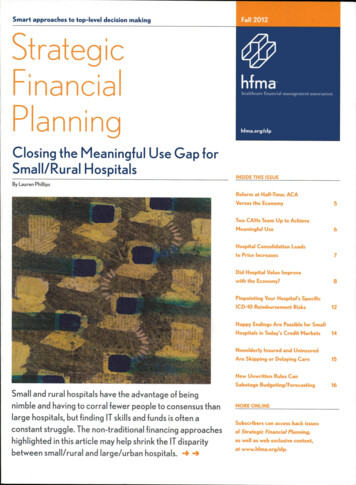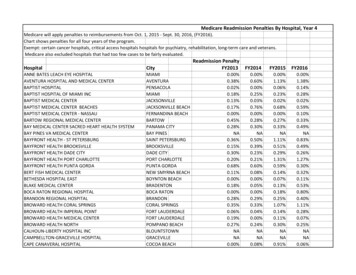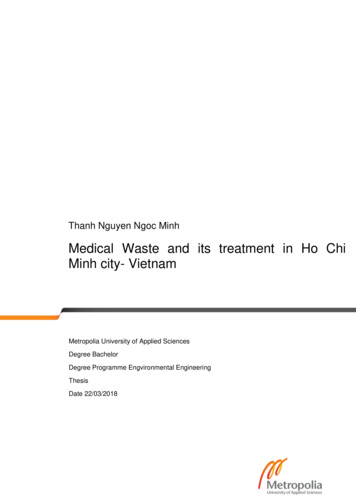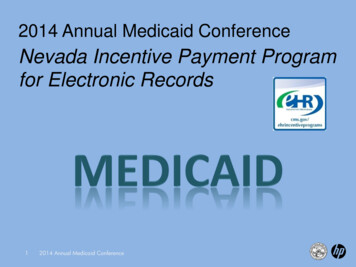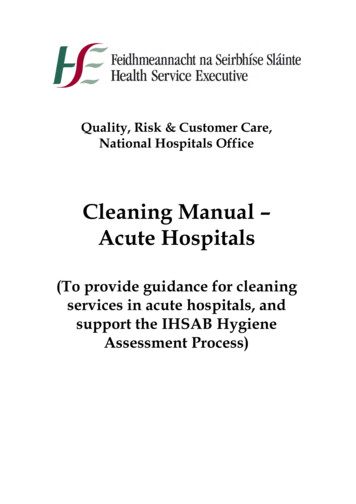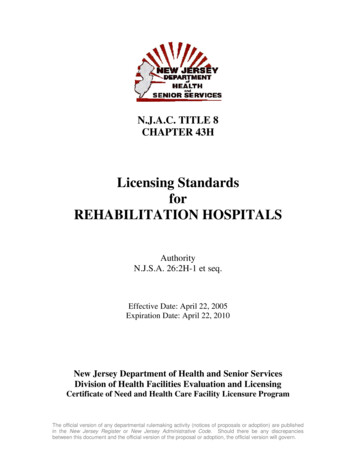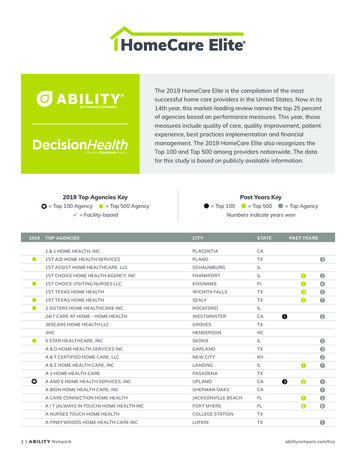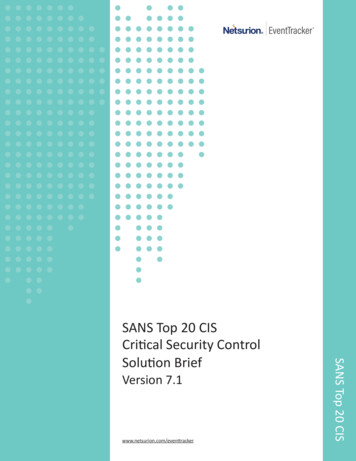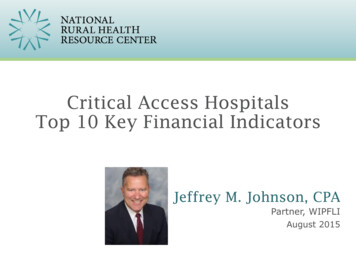
Transcription
Critical Access HospitalsTop 10 Key Financial IndicatorsJeffrey M. Johnson, CPAPartner, WIPFLIAugust 2015
Top 10 Key Financial Indicators for CriticalAccess Hospitals (CAHs)Objective of the Discussion: To gain a high-levelunderstanding of how to interpret financialindicators for CAHs and why it is importantDiscussion Agenda: Provide definition of key financial indicatorsimportant to CAHs How to use and interpret the key financialindicators Using external data to understand your financialposition Provide resources for industry key financialindicator benchmarks
Why is it Important in Health Care Organizationsto Monitor Financial Performance? Do we view our operations and make decisionsfrom a “hospital centric” or “care continuum”perspective? Can we generate the required margin to supportour ongoing mission? Can we and/or should we maintain all ourcurrent service line offerings into the future?Are they being provided in the most efficientdelivery modality? Do our leaders, managers and patient caregivers have access to useful information tosupport current and future daily decisionmaking?Where does benchmarking fit?
Why is it Important to MonitorFinancial Performance?Performance measurement can be defined as: The regular collection, reporting, discussion andanalysis of data that is tied to some measure ofprocess improvement It can track progress on strategy, monitor financialoutcomes, monitor operational efficiency, patientquality, etc.Without BenchmarkingWith BenchmarkingInternally focusedUnderstand the competitionChange is evolutionaryNew ideas and proven practicesLow commitmentHigh commitmentCatching upLeaderReactiveProactiveAssessment is perceivedAssessment is real
Top 10 CAH Key Financial Indicators FormatThe following top 10 key financial indicators were agreedupon by participants during the 2012 National CAH Summitin Minneapolis, Minnesota, led by the National Rural HealthResource Center. Each of the following metrics areformatted based on the example below that: Describes the metric Defines how the metric is computed Provides the desired trend for each metric (i.e., up ordown) Provides the desired position relative to the median (i.e.,above or below)
Days Cash on Hand Measures the number of days an organization couldoperate if no additional cash was collected or received(liquidity ratio)Days Cash on Hand(All Sources)Cash Short-Term Investments Unrestricted Long-TermInvestments(Total Expenses – Depreciation)/365Trend:UpMedianPosition:Below Lending organizations view this as a critical ratio in theassessment of a hospital’s ability to finance newprojects It represents the amount of dollars readily available tomeet short-term obligations and make debt paymentsshould an organization experience short-term financialdifficulties Favorable values are above the median, and the 2013CAH U.S. Median 68.83 days
Days in Net Accounts Receivable Measures the number of days it takes anorganization to collect its payments (liquidityratio)Days in NetAccountsReceivableNet Patient Accounts Receivable(Including adjustments and settlements)Net Patient Service Revenue/365Trend:DownMedianPosition:Below High values reflect a long collection period andindicate problems in the organization’s businessoffice with regard to billing or collecting payments Improvement in days in accounts receivable canmean hundreds of thousands of dollars inimprovement in cash on hand Favorable values are below the median, and the2013 CAH U.S. Median 54.20 days
Days in Gross Accounts Receivable Tests the net days in accounts receivable with agoal of being the same amount of time as netdays in accounts receivableDays in GrossAccountsReceivableGross Patient Accounts Receivable(Excludes settlements)Gross Patient Service Revenue/365Trend:DownMedianPosition:Below Days in gross accounts receivable is important totrack and compare to net accounts receivable toassess the revenue cycle performance Gross and net days are close in value in highlyfunctioning business offices Similar characteristics as “net” accountsreceivable
Total Margin Measures the control of expenses relative torevenue (profitability ratio)TotalMarginExcess of Revenue OverExpensesTotal RevenueX 100Trend:UpMedianPosition:Above Total margin indicates the organization’soverall profit Favorable values are above the median, andthe 2013 CAH U.S. Median 2.51%
Operating Margin Measures the control of operating expensesrelative to operating revenue related to patientcare (profitability ratio)OperatingMarginIncome from OperationsTotal RevenueX100Trend:UpMedianPosition:Above This measure reflects the overall performanceon the CAH’s core business: providing patientcare Favorable values are above the median, andthe 2013 CAH U.S. Median 0.99%
Debt Service Coverage Ratio Measures the ability to pay obligations related tolong-term debt (capital structure ratio)Debt ServiceCoverageExcess of Revenue Over Expenses Depreciation Interest ExpensePrincipal Payments Interest ExpenseTrend:UpMedianPosition:Above The higher the value of the debt servicecoverage ratio, the greater the “cushion” torepay outstanding debt or take on additionalobligations Favorable values are above the median, andthe 2013 CAH U.S. Median 2.73 times
Long-Term Debt to Capitalization Measures the percentage of net assets (orequity) that is debt (capital structure ratio)Long-Term Debt toCapitalizationLong-Term DebtLong-Term Debt Net AssetsX100Trend:DownMedianPosition:Below Favorable values are below the median, andthe 2013 CAH U.S. Median 17.02% Has flattened out due to economy the last fewyears; however, expect this ratio to increaseover the next two to three years
Average Age of Plant Measures the average age in years of thebuildings and equipment of an organization(operations ratio)Average Age ofPlantAccumulated DepreciationDepreciation ExpenseTrend:DownMedianPosition:Below Average age of plant is a good indicator ofdistress with older hospitals having greaterproblems in upkeep; not to mention providerrecruitment and patient retention Favorable values are below the median, andthe 2013 CAH U.S. Median 9.77 years
Salaries to Net Patient Revenue Measures labor costs relative to the generation ofoperating revenue from patient care (operationsratio)Salaries to Net PatientRevenueSalary ExpenseNet Patient RevenueX100Trend:DownMedianPosition:Below Salaries are a major part of the expense structureand require close management Reviewing the costs can help a CAH assess itsstaffing efficiency Favorable values are below the median, and the2013 CAH U.S. Median 45.57%
Payor Mix Percentage Inpatient Payor Mix:InpatientPayor MixInpatient Days for PayorTotal Inpatient Days – Nursery BedDays – Nursing Facility Swing BedDaysX 100Trend:DownMedianPosition:BelowX 100Trend:DownMedianPosition:Below Outpatient Payor Mix:OutpatientPayor MixOutpatient Charges for PayorTotal Outpatient Charges The 2013 CAH U.S. Median for Medicare inpatientand outpatient payor mix was 73.01% and37.9%, respectively. Favorable values are belowthe median
CAH Financial Indicators and BenchmarkReporting Resources CAH Finance 101 Manual: Designed to be non-technical andprovide answers to frequently asked questions regarding CAHfinance and financial performance Flex Monitoring Team (Free): Compiled and distributed annuallyto every CAH individually using publicly available cost-reportdata; data 2 years old Optum (Not free) (formerly Ingenix/Cleverly) Survey data is atleast 18 months old Wipfli LLP (free for participants; also have free abridgedversion): Benchmarking service exclusively for CAHs. Survey data is9 to 12 months old A robust set of operational, productivity, utilization andfinancial benchmarks
Jeffrey M. Johnson, CPAPartnerWipfli LLP Health Care Practice201 West North River DriveSuite 400Spokane, WA 99201(509) 232-2498jjohnson@wipfli.comwww.wipfli.comGet to know us better:http://www.ruralcenter.org
assess the revenue cycle performance Gross and net days are close in value in highly functioning business offices Similar characteristics as "net" accounts receivable . Salaries to Net Patient Revenue Outpatient Payor Mix: The 2013 CAH U.S. Median for Medicare inpatient and outpatient payor mix was 73.01% and 37.9% .
